Epoxy Resin Market Outlook 2020-2027
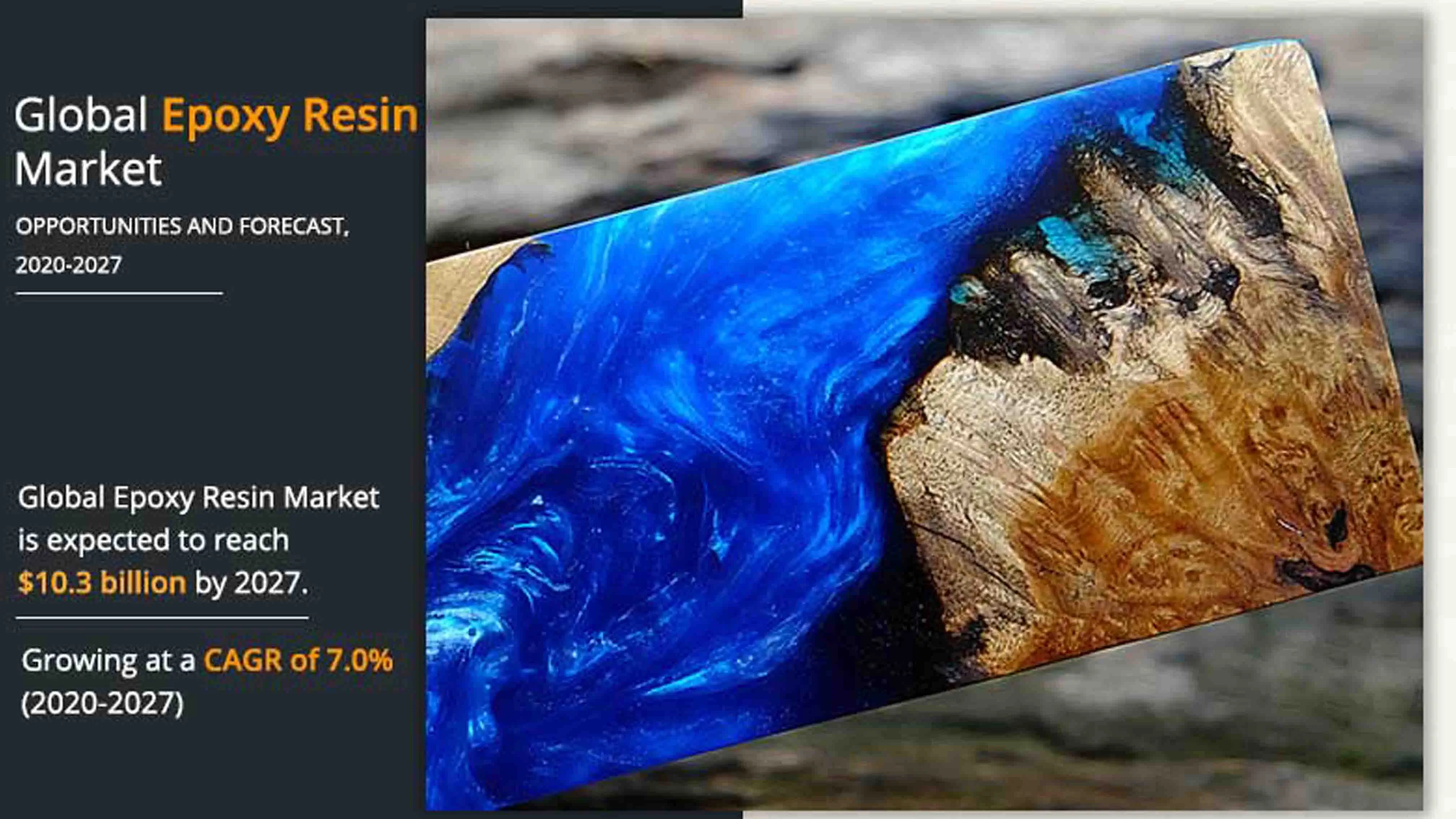
The epoxy resin market was valued $5.9 billion in 2019, and is projected to reach $10.3 billion by 2027, at a CAGR of 7.0% from 2020 to 2027.
Epoxy resin is a thermosetting polymer formed by copolymerization of an epoxide with another compound having two hydroxyl groups. These resins are known for their enhanced performance in numerous industrial applications, owing to properties such as corrosion resistance, high thermal stability, superior mechanical strength, notable toughness, prolonged durability, resistance to chemical & moisture, and superior adhesion. Thus, epoxy resins majorly find their application across paints & coatings, adhesives, composites, and electronic encapsulation industries.
Increase in demand from end-use industries and surge in need for lightweight composites in aerospace and wind turbine applications are presently driving the growth of the global epoxy resin market. Vehicle manufacturers are adopting lightweight composite materials to meet the demand for design freedom, flexibility, high strength, and reduced vehicle weight. Moreover, in wind turbine blades, epoxy resins offer stronger mechanical performance, particularly tensile and flexural strength. Thus, increase in acceptance of this resin in the wind power industry is expected to boost the market growth. The number of end-use industries is rising duet increase in income, rise in urbanization, and surge in technology-intensive activities, which, in turn, boost the demand for epoxy resins, globally. Steady economic gains and rise in industrialization are further expected to contribute toward the growth of the global epoxy resin market.
However, the reaction between the key raw materials, epichlorohydrin (ECH) and bisphenol A (BPA) is the most common way to produce epoxy resin. Both ECH and BPA release toxic gases during combustion. Higher the temperature of combustion, greater is the amount of gases emitted. Moreover, epoxy resins are non-biodegradable. Thermoset resins cannot be recycled, and are not biodegradable. Thus, all these concerns significantly hamper the growth of the global market. Moreover, fluctuation is ECH prices affects the production cost of this resin. In addition, changes in demand and supply of ECH and BPA majorly impact the market. On the contrary, the development of bio-based epoxy resins is expected to remunerative opportunities for the expansion of the global epoxy resin market. Epoxy resins produced from bio-based raw materials can be a part of bio-polymers in future. Bio-based epoxy pre-polymers can be derived from sorbitol, natural sugars, and isosorbides. In addition, ECH can be manufactured using bio-sourced glycerol derived from oil plants. The production of epoxy resin from bio-sourced material is expected to create diverse growth opportunities for key players. Thus, its impact is expected to remain high throughout the forecast period. Moreover, increase in R&D activities to introduce new, improved epoxy resin systems for specific applications contributes toward the market growth.
The global epoxy resin market is segmented into type, physical form, application, end user, and region. On the basis of physical form, the market is categorized into solid, liquid, and solution epoxy. Depending on type, it is divided into diglycidylether bisphenol A (DGBEA), diglycidylether bisphenol F (DGBEF), novolac, aliphatic, and glycidylamine, and others. The applications covered in the study include paints & coatings, adhesives, composites, and electronic encapsulation & others. By end user, the market is segregated into building & construction, transportation, general industrial, consumer goods, wind power, aerospace, marine, and others. Region wise, it is analyzed across North America, Europe, Asia-Pacific, and LAMEA.
The key players operating in the global epoxy resin market are BASF SE, Atul Ltd., Dow Chemical Company, Hexion Inc., Huntsman Corporation, Kukdo Chemicals Co. Ltd., Nan Ya Plastics Corporation, Olin Corporation, Solvay SA, and Techstorm Advanced Materials. These major key players have adopted product launches as their key developmental strategy to expand their product offerings and stay competitive in the global market.
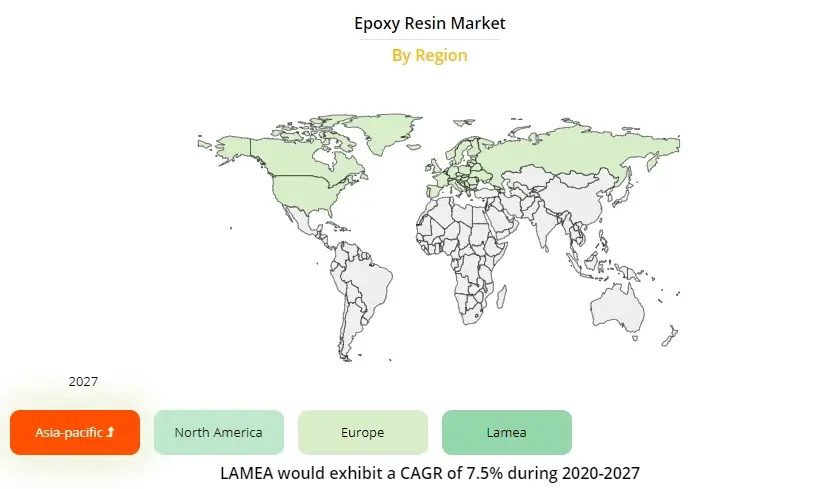
Asia-Pacific accounted for the largest market share in 2019, owing to the presence of a number of end users in the region. Asia-Pacific and Europe collectively accounted for around 74.1% share in 2019, with the former constituting around 60.1% share. LAMEA and North America are expected to witness considerable CAGRs of 7.5% and 7.3%, respectively, during the forecast period. The cumulative share of these two segments was 25.9% in 2019, and is anticipated to reach 26.7% by 2027.
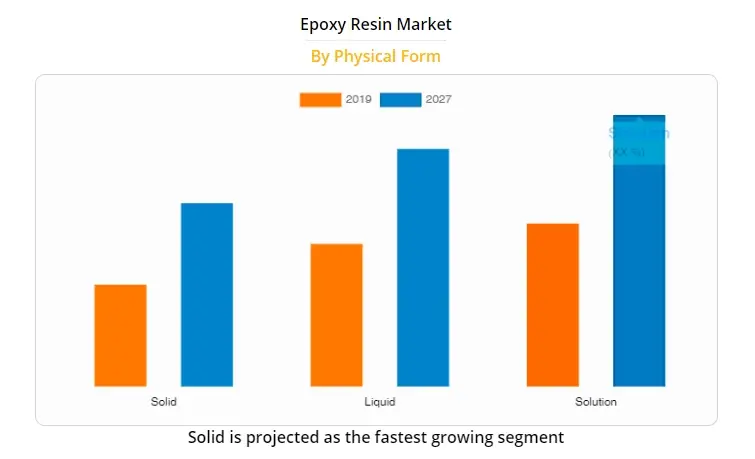
Solution epoxy resin accounted for the highest revenue in 2019, and is projected to grow at a CAGR of 6.70%, owing to increase in demand for solution-based epoxy resin systems in electrical & electronic applications.
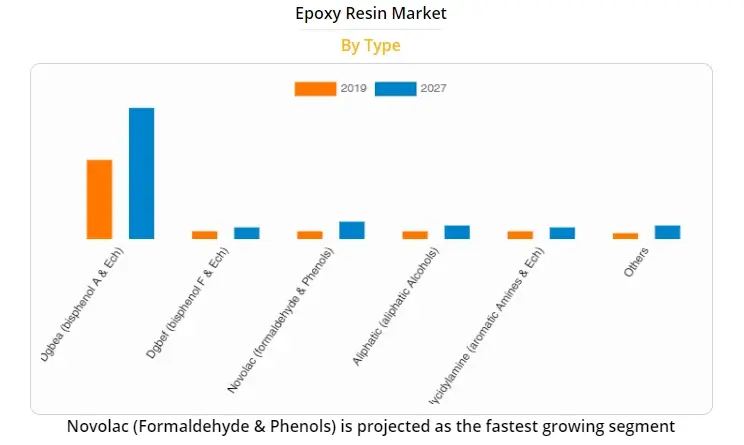
DGBEA (bisphenol A& ECH) accounted for the largest market share in 2019, and is projected to grow at a CAGR of 6.4%. However, the novolac segment is projected to exhibit the highest CAGR of 12.6%, owing to widespread use of novolac in industrial coatings, adhesives, and composites.
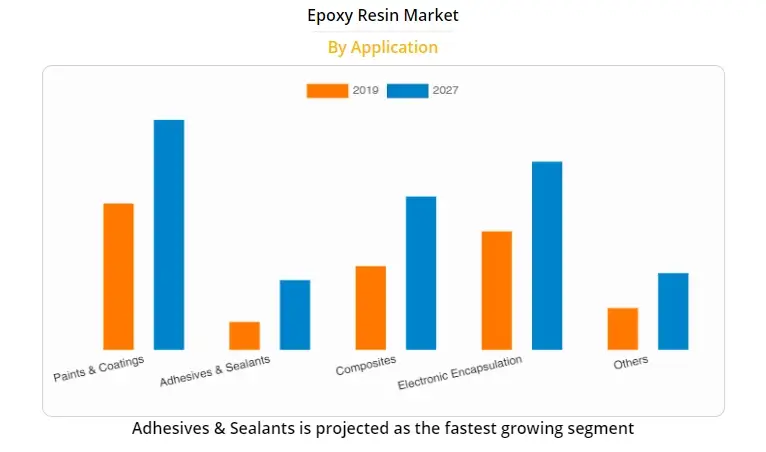
The paints & coatings segment accounted for the largest market share in 2019, and is projected to grow at a CAGR of 6.1%. However, the adhesives & sealants is projected to grow at the highest rate in the global epoxy resin market, owing to the fact that adhesives & sealants are widely applicable in the construction, automotive, power, and electronic sectors.
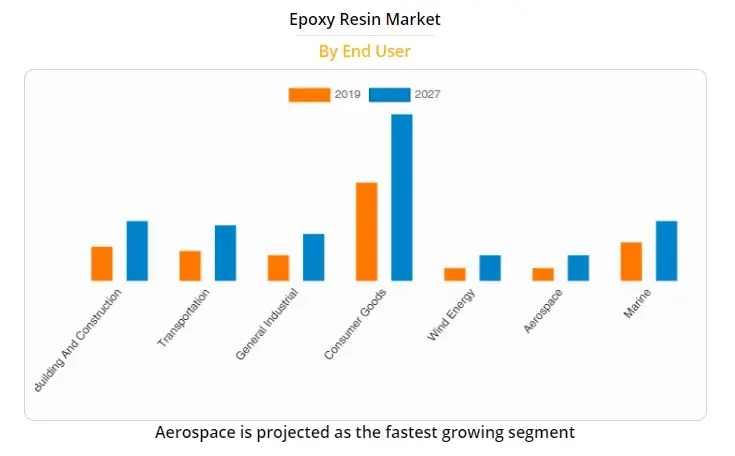
The paints & coatings segment accounted for the largest market share in 2019, and is projected to grow at a CAGR of 6.1%. However, the adhesives & sealants is projected to grow at the highest rate in the global epoxy resin market, owing to the fact that adhesives & sealants are widely applicable in the construction, automotive, power, and electronic sectors.
Key Benefits for Stakeholders:
• The global epoxy resin market analysis covers in-depth information of major industry participants.
• Porter's five forces analysis helps to analyze the potential of buyers & suppliers and the competitive scenario of the industry for strategy building.
• Major countries have been mapped according to their individual revenue contribution to the regional market.
• The report provides an in-depth analysis of the global epoxy resin market forecast for the period 2020–2027.
• The report outlines the current global epoxy resin market trends and future estimations of the global epoxy resin market from 2019 to 2027 to understand the prevailing opportunities and potential investment pockets.
• The key drivers, restraints, and opportunity and their detailed impact analyses are elucidated in the study.
Key Market Segments:
By Type
- DGBEA
- DGBEF
- Novolac
- Aliphatic
- Glycidylamine
- Others
By Physical Form
- Solid
- Liquid
- Solution
By Application
- Paints & Coatings
- Adhesives
- Composites
- Electronic Encapsulation & Others
By Application
- Building & Construction
- Transportation
- General Industrial
- Consumer Goods
- Wind Power
- Aerospace
- Marine & Others
By Region
- North America
- U.S.
- Canada
- Mexico
- Europe
- Germany
- France
- UK
- Spain
- Italy
- Others
- Asia-Pacific
- India
- China
- Japan
- Korea
- Australia
- Others
- LAMEA
- Brazil
- Saudi Arabia
- South Africa
- Rest of LAMEA
This article originated from: Allied Market Research
Write a comment